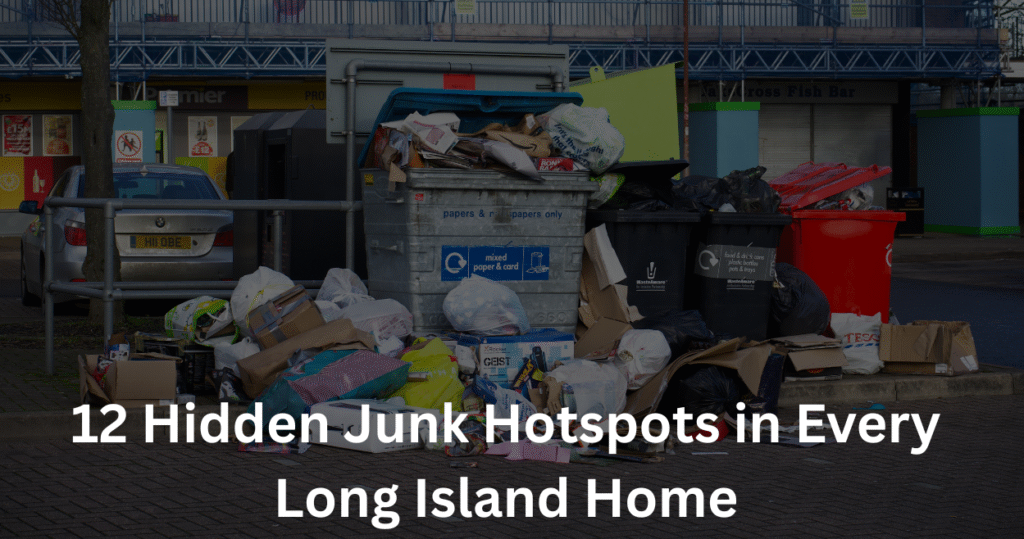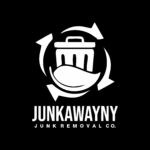
Long Island homeowners know the struggle all too well. Despite regular cleaning and organizing efforts, clutter seems to multiply in the most unexpected places. While you may think you have a handle on your home’s organization, there are sneaky spots where junk accumulates without you even realizing it. These hidden hotspots are silently collecting dust, taking up valuable space, and making your home feel more chaotic than it should.
Whether you’re dealing with a cozy ranch in Levittown or a sprawling colonial in Garden City, these problem areas exist in virtually every Long Island home. Identifying and tackling these hidden junk magnets can transform your living space and restore that sense of order you’ve been craving.
1. The Garage Corner Behind the Water Heater
That dark, forgotten corner behind your water heater is likely harboring years of accumulated junk. Old paint cans, rusty tools, holiday decorations from 1995, and mysterious boxes pile up in this hard-to-reach spot. Most homeowners avoid this area entirely, making it the perfect hiding place for items that should have been discarded long ago. Take a flashlight and prepare to be amazed by what you discover lurking in the shadows.
2. Basement Storage Under the Stairs
The triangular space beneath basement stairs becomes a black hole for household items. Broken appliances, outgrown sports equipment, old computer monitors, and boxes of cables create a towering mountain of forgotten possessions. This area is particularly problematic because it’s out of sight and difficult to access, making it easy to keep shoving items in without ever taking anything out.
3. Attic Insulation Gaps
Between the pink fiberglass insulation and around the HVAC ducts, small items tend to disappear into the attic void. Old magazines, children’s toys, seasonal decorations, and random household items somehow find their way into these crevices. The extreme temperatures and poor lighting make this area even more neglected, allowing junk to accumulate for years without detection.
4. Kitchen Junk Drawer Overflow
Every Long Island kitchen has at least one junk drawer, but the real problem occurs when that drawer spawns offspring. Secondary junk drawers multiply throughout the kitchen, filled with expired coupons, broken phone chargers, mysterious keys, and enough rubber bands to supply a small office. These drawers become archaeological sites where items from different decades coexist in chaotic harmony.
5. Bedroom Closet Floor
The floor of bedroom closets, especially master bedrooms, becomes a graveyard for shoes, bags, and random items. Old sneakers, purses from previous decades, wrapping paper rolls, and electronics boxes create a carpet of clutter that makes finding anything nearly impossible. The darker corners of closet floors are particularly problematic, as items can remain hidden for years.
6. Bathroom Vanity Cabinets
Behind the bathroom vanity doors lies a pharmacy of expired medications, old makeup, and mysterious beauty products. Travel-sized toiletries from hotels, hair accessories, and cleaning supplies create a jumbled mess that makes daily routines frustrating. The humid environment also means that many items deteriorate while remaining forgotten in these cramped spaces.
7. Mudroom Shoe Pile
Long Island homes with mudrooms inevitably develop shoe mountains that grow throughout the seasons. Winter boots mix with summer sandals, creating towering piles that make it impossible to find matching pairs. The area becomes a catch-all for umbrellas, gloves, scarves, and outdoor gear that never quite makes it to proper storage.
8. Home Office Cable Chaos
Behind desks and entertainment centers, a spaghetti-like tangle of cables creates visual chaos and functional problems. Old computer cables, phone chargers, ethernet cords, and power strips form an impenetrable web of technological debris. This electronic graveyard makes it difficult to clean properly and creates a fire hazard in many homes.
9. Laundry Room Shelving
Laundry room shelves become repositories for cleaning supplies, both current and ancient. Half-empty detergent bottles, fabric softener sheets, old rags, and mysterious cleaning products create a cluttered landscape that makes doing laundry more stressful than necessary. The humid environment also means that many items deteriorate while taking up valuable space.
10. Kids’ Playroom Toy Graveyards
Underneath toy bins and behind play furniture, broken toys and forgotten games create hidden junkyards. Missing puzzle pieces, toys with dead batteries, and craft supplies mix together in a colorful chaos that makes cleaning overwhelming. These areas require regular excavation to prevent complete toy anarchy.
11. Dining Room China Cabinet
The lower cabinets of china hutches and dining room storage become final resting places for entertaining supplies. Mismatched plates, old tablecloths, candles, and serving pieces create confusion when trying to host gatherings. Many items remain untouched for years, taking up space that could be used for frequently needed items.
12. Outdoor Shed Tool Maze
Garden sheds and outdoor storage areas develop their own ecosystem of forgotten tools and equipment. Broken lawn mowers, rusted gardening tools, old fertilizer bags, and seasonal decorations create obstacle courses that make finding anything a treasure hunt. The outdoor elements also mean that many items deteriorate while remaining unused.
Taking Action Against Hidden Junk
Identifying these problem areas is the first step toward reclaiming your Long Island home. Set aside dedicated time to tackle each hotspot systematically, armed with trash bags, donation boxes, and a ruthless attitude toward items that no longer serve you. Remember that every item you remove creates space for the things that truly matter in your daily life.
Consider implementing organizational systems in each area to prevent future accumulation. Simple solutions like labeled bins, regular purging schedules, and “one in, one out” policies can keep these hidden hotspots from becoming overwhelming again.
Your Long Island home deserves to be a sanctuary, not a storage facility for forgotten possessions. By addressing these twelve hidden junk hotspots, you’ll create a more organized, peaceful, and functional living environment that truly reflects your lifestyle and values.

Hi, this is a comment.
To get started with moderating, editing, and deleting comments, please visit the Comments screen in the dashboard.
Commenter avatars come from Gravatar.